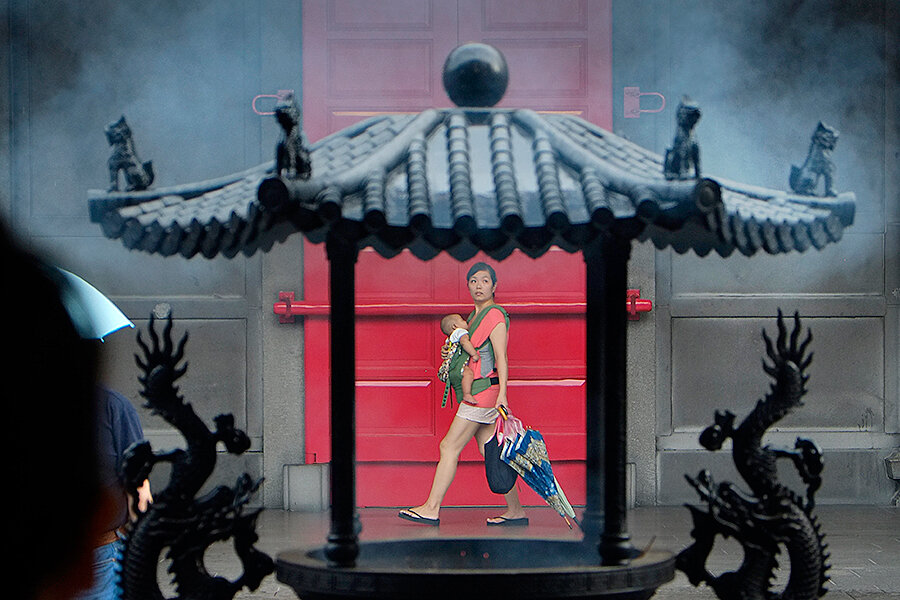Once sidelined, Taiwan's mixed-race children find new embrace
Loading...
| Taipei
Huang Hui-mei used to dread being asked about her racial heritage. The daughter of a Vietnamese mother and Taiwanese father, she knew that having Southeast Asian heritage was seen as a marker of low status in Taiwan.
But now, Hui-mei, a high school sophomore whose mother was driven by poverty to come to Taiwan, is finding that people are more curious – in a good way – about her background.
Taiwanese are increasingly thinking of themselves as a multi-ethnic society – a concept that is reshaping Taiwan's story of its basic identity. That has larger significance now as a generation of younger Taiwanese move to more clearly distinguish their island and its culture from that of political rival, China.
“Now if your teachers know your mother is from Vietnam, they give you more help,” says Hui-mei. “I think Taiwan will need those of us with a different heritage.”
Conservative estimates indicate that Taiwan is home to about 117,000 children with foreign parents, most from poorer regions of Asia. They are expected to gradually blend their food, customs, and languages into Taiwan’s ethnic Chinese majority.
Although that number will not dramatically tip the racial balance of Taiwan’s 23 million people any time soon, mainstream Taiwanese are starting to treat mixed-race offspring and their parents as as valued and distinct, a change that many would not have anticipated a few years ago.
“This will be a social issue and it’s something you have to pay attention to. Some people [of Southeast Asian descent] might get rich and some might become more influential,” says Nathan Liu, international affairs professor at Ming Chuan University in Taiwan. “That will probably happen in the future. To see different cultures [grow] is a good thing for the young generation.”
Taiwan’s ethnic roots are predominantly Chinese. Migrants from the mainland began arriving from the southeast coast of China about 400 years ago, and they quickly outnumbered the half-dozen native aboriginal populations that are about 2 percent of the population.
70 percent reject unification
In the decades after the Chinese Nationalist forces fled to Taiwan from the mainland after World War II, there were fears of high birth rates and waves of mixed-nationality children. That never happened. If anything, birth rates are seen as too low in Taiwan, with one or two children as the norm for couples of all makeups.
The Chinese ethnic link has bolstered Beijing’s claims that China and Taiwan must eventually unite politically despite nearly seven decades of self-rule in Taiwan that is much prized by locals. More than 70 percent of Taiwanese oppose unification with China, a government poll found last year after youth groups organized mass protests against closer relations with Beijing.
A multi-ethnic Taiwan represents a further departure from the way mainland China thinks about race and nationalism. During the anti-Beijing opposition party’s eight-year rule, which ended in 2008, former president Chen Shui-bian more than doubled the budget for aboriginal education, and he began to showcase the hundreds of years of life and culture on the island that Chinese migrants had as their heritage.
Mr. Chen’s successor, President Ma Ying-jeou of the Nationalist [KMT] Party, also contributed to change by opening Southeast Asian language courses in more than 300 elementary schools in 2012 – with plans to cover all 2,600 schools by 2018. The goal is to raise general respect for migrants and their children.
Migrants of low social status have often looked to assimilate quickly. The 520,000 migrants in Taiwan tend to learn Chinese and downplay their own culture at home rather than extolling it to their children.
'Undergoing a profound change'
While the number of migrants has tapered due both to crackdowns on fake marriages and improved economic conditions in Southeast Asia, they are visible. Some run Filipino supermarkets and offer English-speaking Catholic masses. Muslim Indonesian women in burkas gather in crowded public places with friends for chats in Bahasa. Indonesian women often work as live-in maids, another foreign influence for Taiwanese children.
“The structure of our country’s population is undergoing a profound change,” says Lee Ming-fang, a senior administrative officer with Taiwan’s National Immigration Agency. “It’s not a new ethnicity, but it’s a new group.” It may be a welcome one, Ms. Lee says. “We’ve already have an immigrant society and we have no natural advantages,” she says.
Taiwan stands to absorb more of Southeast Asia as the children of migrants mature.
Hui-mei, the teenager, says her link to Vietnam may be useful for Taiwanese entrepreneurs who want to open factories in the fast-growing Southeast Asian manufacturing hub. She speaks Vietnamese and visits her mother’s hometown of Ho Chi Minh City during school holidays.
Indonesian parents have a reputation for being tough on homework, meaning high grades for their children, says Chang Cheng, owner of the Brilliant Time Bookstore, a suburban Taipei seller with titles in Southeast Asian languages. “Even if their Mandarin isn’t too strong, the mothers will just stare at their children as they do their homework,” he says.
Abby Lu’s parents, both from the Philippines, encouraged the 23-year-old Taipei university graduate to pursue music, different from the groundswell of Taiwanese families that push their children toward salaried jobs. The songwriter-guitarist in a local band is trying for a first album and is getting attention for performances at a Taipei shopping mall.
Taiwanese friends used to ask searching questions when Ms. Lu would take calls from home in Tagalog, she recalls. Now, she says, they “don’t really care.” New immigrants and a bolder mixed-race young adult population will polish Taiwan’s unique identity, she forecasts.
“If more foreigners come to Taiwan, they will know more about the Taiwanese and understand them better, and the more they understand, the more those countries will see Taiwan as an independent country,” she says.
Political movements seeking ways for Taiwan to stand up to China may also point to the mixed-race younger generation.
“The green political leaders might try that, though I’m not sure, so it’s an interesting question,” says Lin Chong-pin, a retired strategic studies professor in Taiwan, referring to Taiwan’s political faction that opposes the KMT and supports increased self-rule.






